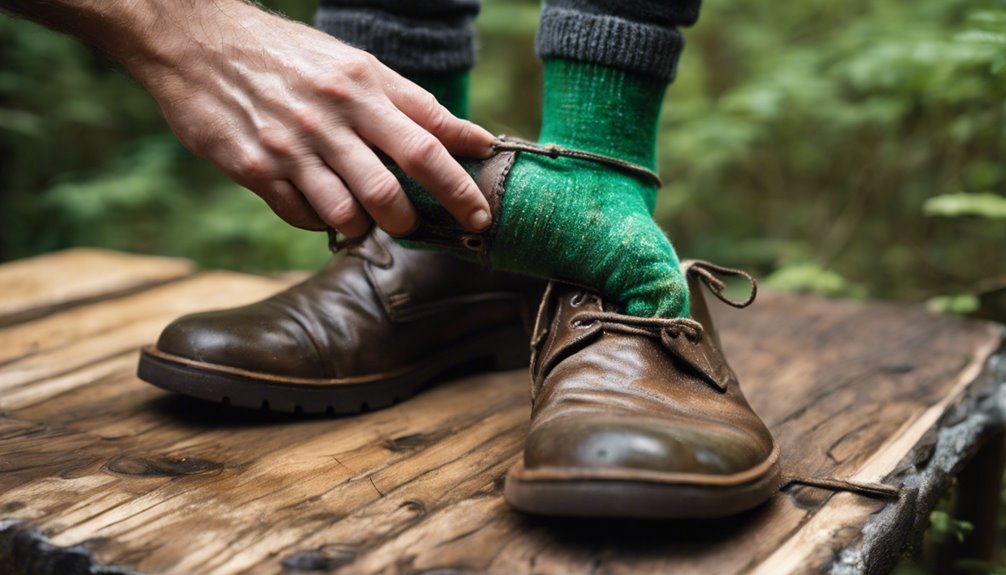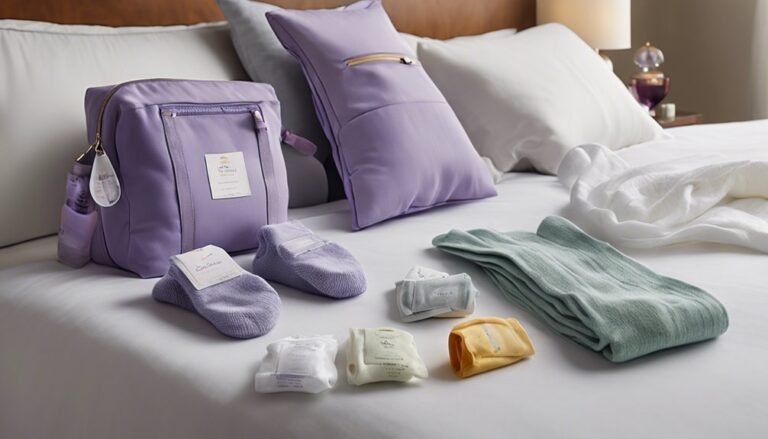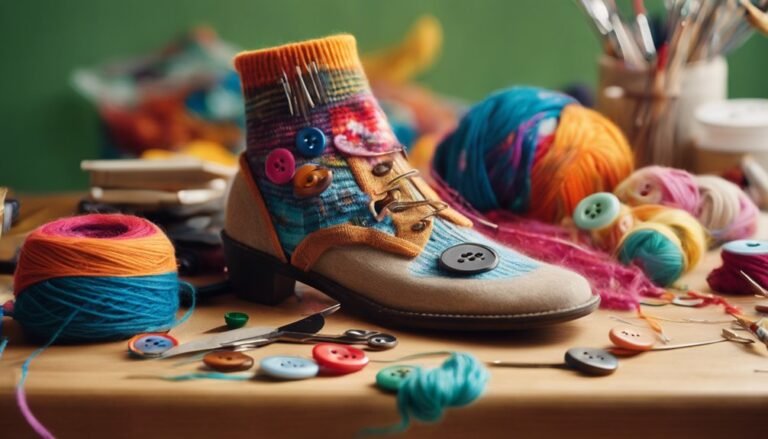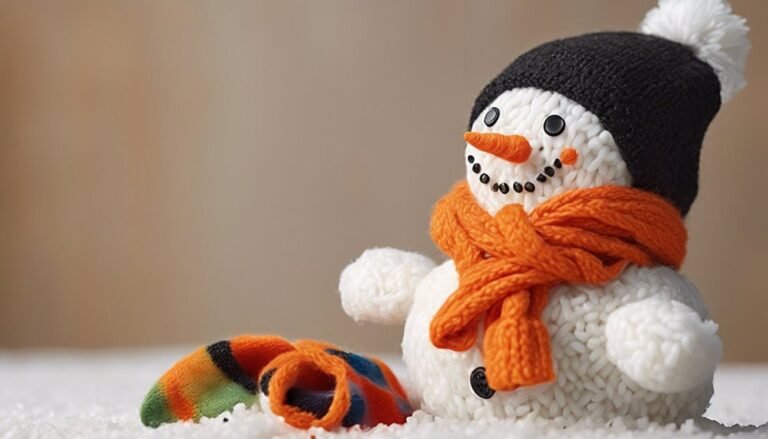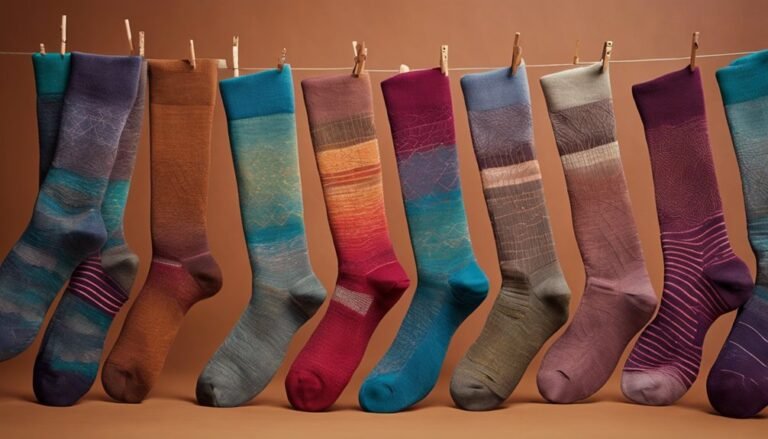How to Waterproof Your Socks for Outdoor Adventures
Imagine this: You're on a hiking adventure, traversing through lush forests and crossing babbling brooks. The sky is clear, and the air is crisp.
But then, as you step into a shallow stream, you feel the cold water seep into your socks. Instantly, your feet are soaked, and the discomfort sets in. What if you could have avoided this soggy situation?
To waterproof your socks for outdoor adventures, start with synthetic materials like nylon. Apply beeswax or a silicone spray for a protective layer—Nikwax is a reliable brand.
Make certain the socks are clean, and spray while holding the can 6-8 inches away. Let them air-dry. Regularly inspect and maintain them with mild detergent and waterproofing renewals.
Avoid direct sunlight during drying to preserve the integrity of the waterproof coating. Now that you have the basics, it's time to dive into further details.
Understanding the Importance of Waterproof Socks
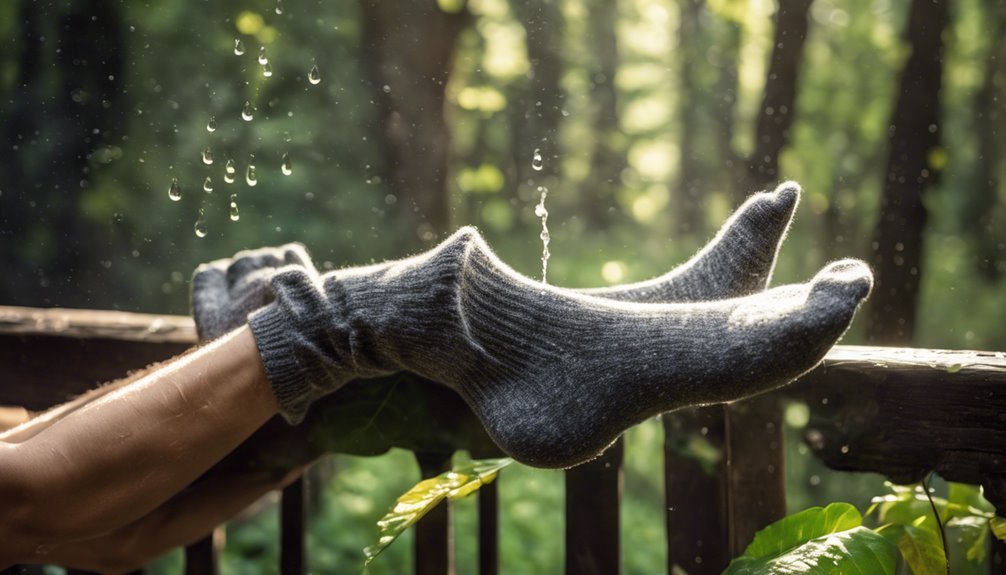
Whether you're hiking, biking, or camping, waterproof socks are an essential component of your outdoor gear. Their waterproof benefits keep your feet dry, enhancing comfort and preventing blisters. Look for socks with a breathable membrane like Gore-Tex, which effectively blocks water while allowing moisture vapor to escape. This dual function is vital for maintaining comfort during rigorous activities. Regarding sock durability, consider options reinforced with nylon or Merino wool. These materials offer longevity and resist wear and tear, providing you with the freedom to explore without worry. Brands like SealSkinz and DexShell are highly recommended for their reliable waterproof technology and durability. By investing in quality waterproof socks, you guarantee your feet remain protected, no matter the adventure.
Choosing the Right Materials for Sock Waterproofing
When selecting materials for waterproofing your socks, you'll want to take into account solutions like Gore-Tex and eVent, which are renowned for their breathability and water resistance. Confirm compatibility by checking if the material can withstand repeated exposure to moisture without degrading, as some fabrics like cotton aren't ideal. For peak performance, pair these materials with moisture-wicking layers to keep your feet dry and comfortable during your outdoor adventures.
Best Waterproofing Solutions
An array of waterproofing solutions exists to keep your socks dry during outdoor adventures, and selecting the right materials is essential for peak performance. With freedom in mind, consider these best waterproofing materials and effective methods:
- Silicone Spray: Offers a quick, easy application for a water-repellent layer. Opt for products like Kiwi Camp Dry for optimal results.
- Wax-Based Treatments: Beeswax or paraffin wax provides a durable, flexible barrier. Products such as Nikwax Fabric & Leather Proof are well-regarded.
- Waterproofing Membrane: Consider Gore-Tex liners for an advanced, breathable option that keeps moisture out while maintaining comfort.
- Seam Sealing Tapes: Reinforce your socks' seams with products like Gear Aid Tenacious Tape for added protection against leaks.
Each method allows you to tailor your approach, ensuring your feet remain dry and unrestricted.
Material Compatibility Tips
Selecting the right waterproofing materials for your socks requires a focus on material compatibility to confirm effectiveness and comfort. Start by considering the material types of your socks. Wool and synthetic blends often pair well with waterproofing sprays like Nikwax Fabric & Leather Proof, enhancing fabric performance without compromising breathability. For cotton socks, opt for a silicone-based spray such as Gear Aid Revivex, which adheres well to natural fibers. When applying any waterproofing product, make sure the fabric is clean and dry to maximize adhesion. Always test on a small area first. Remember, too much can lead to stiffness, so apply sparingly. With the right combination, you'll maintain your sock's comfort and flexibility, ready for any adventure. Enjoy your newfound freedom!
DIY Waterproofing Techniques for Socks
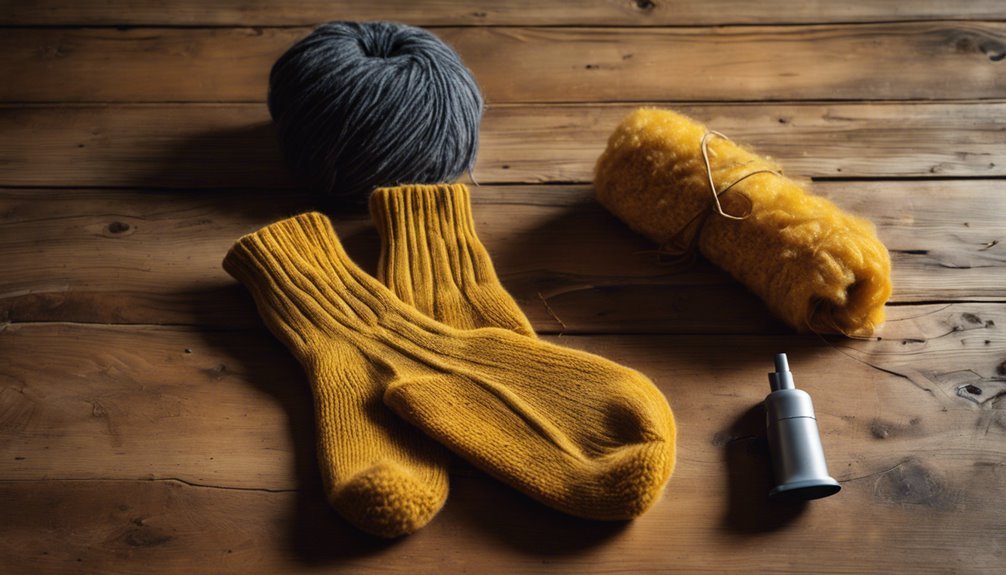
While purchasing waterproof socks can be convenient, understanding how to waterproof your own socks can be both cost-effective and rewarding. With sock material innovations, you can make them both durable and breathable. Here's how you can achieve this:
- Choose the Right Base Material: Opt for socks made of polyester or nylon, as they're ideal for waterproofing.
- Apply a Wax Coating: Melt beeswax and rub it onto the sock's surface. This method provides breathable waterproofing without compromising flexibility.
- Use Linseed Oil: Mix with turpentine for a natural sealant. Apply evenly and let dry thoroughly.
- Silicone Spray: Lightly mist over socks for a quick waterproof layer. Guarantee even application to maintain sock functionality.
Experiment with these methods and enjoy the freedom of dry feet on your adventures!
Using Commercial Waterproofing Sprays and Solutions
When planning your next outdoor adventure, using commercial waterproofing sprays and solutions can confirm your socks stay dry and comfortable. Start by choosing reliable commercial spray options like Nikwax Fabric & Leather Proof or Scotchgard Outdoor Water Shield. These are easy to apply and offer durable protection. Before you spray, verify your socks are clean and dry. Hold the spray can about 6-8 inches away, applying an even coat on every side. Pay special attention to seams and high-wear areas. Let them air-dry completely, ideally in a well-ventilated area. Repeat the process if needed for extra protection. This technique not only keeps moisture at bay but also lets you roam freely, knowing your socks are equipped to handle wet conditions.
Layering Strategies for Enhanced Waterproofing
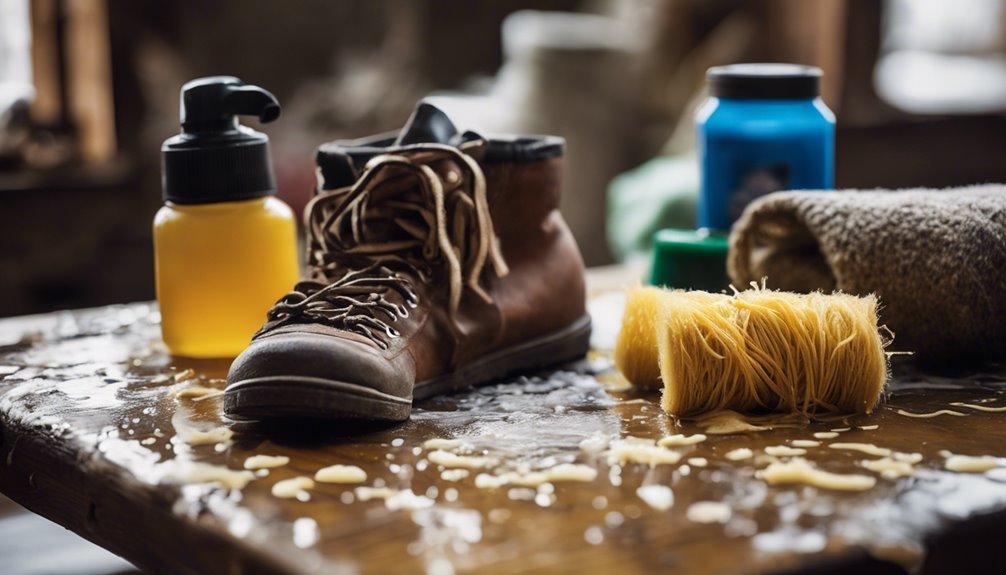
To maximize waterproofing, start with effective sock combinations by pairing moisture-wicking base layers made of merino wool or synthetic blends with waterproof liners like the Sealskinz Waterproof Sock Liners. Utilize these liners to create a barrier against water while maintaining breathability and comfort. When choosing base materials, prioritize those that dry quickly and manage moisture efficiently to prevent any dampness from compromising the waterproofing layers.
Effective Sock Combinations
A strategic approach to sock layering can greatly enhance waterproofing during your outdoor adventures. By combining layers, you can optimize moisture management and stay dry. Here's how you can achieve this:
- Base Layer: Start with a thin, moisture-wicking sock such as the Smartwool PhD Light Elite. This layer keeps sweat away from your skin.
- Insulating Layer: Add a mid-weight merino wool sock for warmth. Darn Tough Hiker Micro Crew socks are an excellent choice for insulation.
- Outer Layer: Finally, choose a durable, water-repellent sock like the Sealskinz Waterproof All Weather Mid Sock for the outermost layer.
- Fit Considerations: Confirm all layers fit comfortably without restricting movement; freedom is key to enjoying your adventure.
Implementing these combinations will keep your feet dry and comfortable.
Utilizing Waterproof Liners
Building upon the foundation of effective sock combinations, another strategy to enhance waterproofing is by incorporating waterproof liners. These liners utilize advanced waterproof technology, providing an extra barrier against moisture. When you're out exploring, layering a waterproof liner between your base sock and outer sock optimizes your sock construction, ensuring dry feet even in the wettest conditions.
To implement this, select a reputable liner like the SealSkinz Waterproof Sock Liners. Slip them over your base sock, ensuring a snug fit without restricting movement. This layering system not only boosts waterproofing but also offers breathability, allowing moisture to escape from your feet without letting water in. With this setup, you'll experience greater freedom and comfort on your outdoor adventures, no matter the weather.
Choosing Proper Base Materials
Selecting the right base materials is essential for achieving ideal waterproofing in your sock layering strategy. Begin with synthetic fibers that excel in moisture management and freedom of movement. Here's a concise list to guide your choices:
- Polypropylene: This lightweight synthetic wicks moisture efficiently, keeping your feet dry during intense activity.
- Nylon: Durable and flexible, nylon offers excellent elasticity, enhancing overall sock comfort and fit.
- Polyester: Known for breathability and quick drying, polyester is perfect for retaining warmth without sacrificing moisture control.
- Merino Wool Blends: While not synthetic, blending merino wool with synthetic fibers provides superior temperature regulation and moisture-wicking properties.
Opt for these materials to guarantee effective layering that balances waterproofing with comfort. Choose freedom with every step, embracing the elements confidently.
Best Practices for Maintaining Waterproofed Socks
Maintaining your waterproof socks' protective qualities requires a few essential practices. First, proper sock care is vital. Hand wash your socks with a mild detergent, avoiding fabric softeners that can compromise waterproofing. For drying techniques, air drying is best—lay them flat on a towel in a well-ventilated area, avoiding direct sunlight and heat sources. This prevents material damage and maintains elasticity.
To extend longevity, consider using a waterproofing spray like Nikwax to restore the water-repellent layer after multiple washes. Regularly inspect your socks for wear, especially at seams, and address any issues promptly. By following these guidelines, you'll guarantee your socks remain reliable companions in your outdoor adventures, granting you the freedom to explore without worry.
Common Mistakes to Avoid When Waterproofing Socks
While maintaining your waterproof socks is important, knowing what not to do is equally vital. Avoiding common misconceptions and errors can enhance your outdoor experience. Here are some mistakes to avoid:
- Skipping Sealant: Don't skip applying a waterproof sealant like Nikwax. It's essential for effective protection.
- Improper Drying: Never dry socks directly under sunlight or in a dryer. Instead, air dry them indoors to prevent material damage.
- Using Harsh Detergents: Avoid harsh detergents that can strip the waterproof coating. Use products like Granger's Performance Wash to maintain integrity.
- Over-layering: Resist the urge to over-layer socks, as it can compromise breathability. Choose a single, high-quality waterproof sock for best comfort.
These tips guarantee your socks remain reliable companions on your adventures.
Testing the Effectiveness of Your Waterproofed Socks
How can you be certain your waterproofed socks are truly up to the task? Start with a simple sock testing method. Fill a bucket with water and submerge just the foot section of the sock for 10 minutes. Remove and check the interior for dampness. If it's dry, you're in good shape. For more precision, use a moisture meter like the Dr.meter Digital Wood Moisture Meter to gauge waterproof performance. Also, test in real-world conditions: wear your socks in a puddle or rainstorm. Consider products like Nikwax Fabric & Leather Proof for better results. Remember, freedom in outdoor adventures comes from reliable gear. So, confirm your socks' waterproof performance is robust before heading out to explore the wild.
Frequently Asked Questions
Can Waterproof Socks Help With Odor Prevention During Hikes?
Imagine an odor so potent it could wake the dead! Waterproof socks offer excellent odor control and moisture management. Opt for Merino wool or bamboo blends; they're engineered to keep your feet fresh and dry during your liberating hikes.
Are There Eco-Friendly Waterproofing Options Available for Socks?
You'll find eco-friendly options using biodegradable materials and natural coatings. Consider products like Nikwax or Grangers, which offer waterproofing solutions. Apply evenly, ensuring full coverage, and let dry completely for peak performance. Enjoy your adventures guilt-free!
How Long Does the Waterproofing Effect Typically Last on Socks?
The waterproofing effect on socks typically lasts 3-4 weeks, depending on usage. For best results, reapply waterproofing treatments regularly. Guarantee sock maintenance by washing gently and using products like Nikwax or Granger's for lasting protection and adventure freedom.
Can Waterproofed Socks Cause Skin Irritation or Allergies?
It's coincidental that those with skin sensitivities might experience allergic reactions from waterproofing agents on socks. To avoid this, opt for hypoallergenic products like Nikwax or Granger's, ensuring freedom from discomfort during your adventures.
Is It Possible to Waterproof Socks Without Affecting Their Breathability?
Yes, you can waterproof socks without losing breathability by using hydrophobic materials and breathable membranes. Consider products like Gore-Tex or eVent, which provide excellent water resistance while allowing moisture and heat to escape, ensuring comfort.

